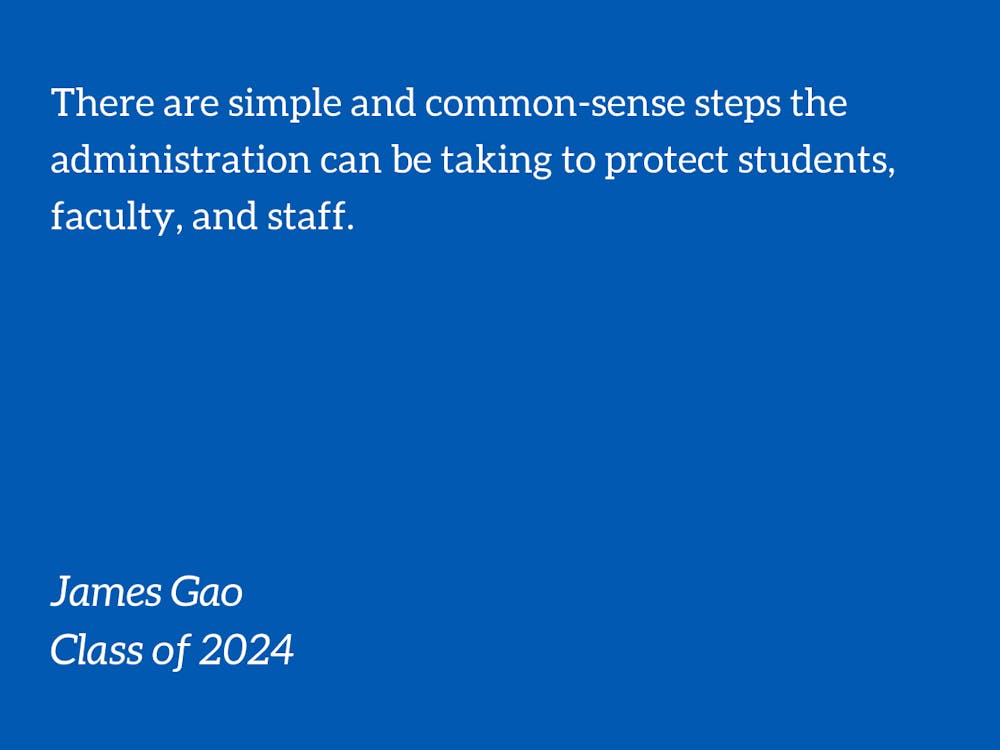The arrival of Omicron in the U.S. has created a winter season defined by uncertainty: test shortages, flight cancellations, and ever-changing guidance from public health authorities. Unfortunately, it seems as if the worst is yet to come. Epidemiologists predict that the Omicron variant will peak in mid-January—where anywhere between 2.5 and 5 million Americans will become infected in just a week. I sympathize with the Duke administration as they face the Herculean challenge of bringing students back to campus. Nonetheless, in the meantime, there are simple and common-sense steps the administration can be taking to protect students, faculty, and staff from infection.
1. Require stronger masks
Ever since the early months of the pandemic, we have known that not all masks are created equal: numerous studies (including one well-publicized one from Duke) have shown that among the various forms of masks currently available, N95s, KN95s, and well-fitted surgical masks reign king. Nonetheless, our public health messaging has lacked the same nuance. After all, “mask up” makes for a punchy slogan. “Wear a well-fitting medical-grade mask over your nose and mouth” doesn’t quite have the same ring. American authorities have made mask-wearing into a binary—you’re either masked and protected, or unmasked and not.
Now, however, our affinity for simplicity threatens to put us at risk. Facing a much more transmissible virus, medical experts suggest that cloth masks are not enough to protect against the spread of Omicron. There are some lingering doubts about surgical masks, but broadly, they seem to fare better. As Duke prepares to return to classrooms on January 18th, it’s clear that lecture halls and classrooms filled with students wearing only cloth masks will only perpetuate community spread and prolong this stage of the pandemic.
As such, the university needs to change its policy around masking for the spring semester. Perhaps they can follow in the footsteps of the Mayo Clinic, which announced earlier this week that all visitors wearing anything but a surgical, KN95, or N95 mask would be given an additional surgical mask to wear over their existing mask. It would be even better if they could repeat their 2020 effort to give every community member three cloth masks, except with KN95 or N95s instead (although, given the cost and non-reusability of these masks, that might be a tough ask). At the very least, they could stop selling cloth masks in the university store—unfortunately, it seems like we’ll have to start finding other ways of showing our school spirit.
Of course, there will never be perfect compliance with any sort of mask mandate. Public health experts’ messaging is simple, in part, because a loose mandate that will get followed is better than a stricter mandate that people ignore. But Duke has the authority to enforce compliance with higher masking standards in classrooms, labs and other campus facilities. In doing so, they can tamp down the rate at which Omicron surges through campus. In the meantime, Duke students should do the best they can to protect others (and return the semester to normalcy) by upgrading their masks.
2. Improve indoor ventilation
Since mid-2020, we have known that proper ventilation plays a key role in reducing the spread of COVID-19. Nonetheless, it seems as if the university has yet to change any policies regarding airflow rate and air quality. Anecdotally, very few classes during the fall semester had any sort of ventilation protocol: open windows, fans, or air purifiers. Given that the scientific community has now widely accepted COVID-19 as an airborne virus, it’s obvious that basic measures that keep air moving are far more important than sanitizing surfaces, temperature checks, and other “hygiene theater” measures we took in the early stages of the pandemic.
The basic solutions to this issue range from easy to extraordinarily complex. On the simple side: open windows in buildings whenever possible! (Although it is winter, Duke will have a lot easier of a time making this happen compared to schools in the Northeast.) On the slightly more costly side, Duke can invest in high-quality air purifiers in classrooms and other common spaces, which can massively reduce viral particle levels in the air.
But if the administration wants to take on a challenging but beneficial long-term situation, they can revamp ventilation systems in university buildings. (I will preface my recommendations here with the disclaimer that I am not an HVAC expert or aerosol scientist, nor was I able to find information about Duke’s current air quality standards online). Given that most American classrooms don’t circulate air as quickly as they should, Duke should change their ventilation systems to minimize air recirculation and accommodate for higher-quality air filters. There are other benefits, like research that suggests a potential association between better-ventilated classrooms and student learning. Most importantly, however, these investments would help us plan for the future. Throughout the pandemic, there has been a serious lack of attention as to how we can prevent airborne viruses from shutting down vital activities like learning again in the future. While HVAC upgrades would be costly, they would signal a willingness to invest in the Duke community’s long-term health. Nonetheless, Duke students can take the immediate step of asking their professors if they can open windows or invest in portable air filters.
Better masks and better ventilation are scientifically-backed measures that can slow the spread of Omicron and allow Duke to stand out among peer institutions. After all, at a time in which both the virus and public health messaging are constantly evolving, the most important pandemic response measures are the ones that will still be the same a few months down the line. If we take these simple steps, we can spend less time worrying about exposure or isolation and more time enjoying a spring semester full of opportunity.
James Gao is a Trinity sophomore. His columns runs alternate Fridays.
Get The Chronicle straight to your inbox
Sign up for our weekly newsletter. Cancel at any time.

